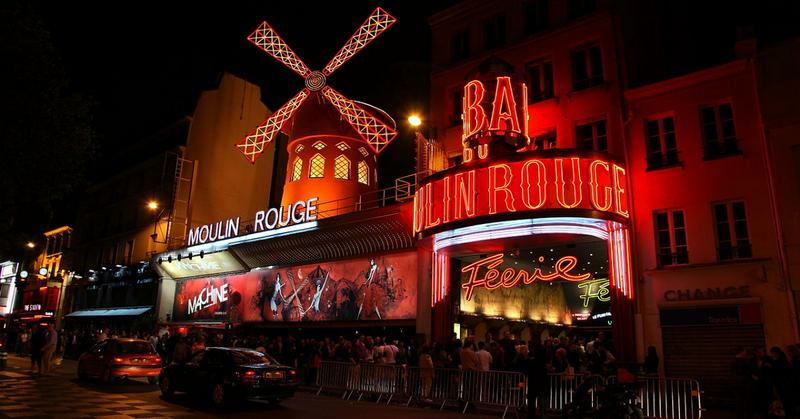The Moulin Rouge: A Famous French Theater That Held The World's Strangest Artists
By | October 4, 2020

Whether you're a lover of art, dance, or pop musicals, you've probably heard of the famous Moulin Rouge, a popular Parisian cabaret house whose real-life heyday spanned the late 19th to early 20th centuries in an era known as Belle Epoque, or "the beautiful epoch." Originally opened in 1889 by Charles Zidler, the Moulin Rouge was located in Montmartre, a district known for its artistic wonderment and bohemian atmosphere, and with its bright red lights and iconic red windmill roof, it was a pretty easy building to spot. In fact, this establishment was the very first building to receive electricity in the entire city of Paris! While at the time, it was most recognized for inventing the wildly popular burlesque version of the can-can dance, plenty of other amazing art and artists were associated with the establishment.

The Stars Of The Moulin Rouge
When it comes to Postimpressionism, you can't do much better than artist and frequent Moulin Rouge patron Henri de Toulouse-Lautrec. Like many aspiring artists, Toulouse-Latrec moved to Paris at a young age and quickly became enamored with the vibrancy and bohemian feel of the city, but he didn't shy away from its seedier side, often painting portraits of the prostitutes he frequented.
As a result, when the Moulin Rouge reached out for his help with their advertisements, he happily accepted, unlike many other respected artists of the area. Naturally, Toulouse-Lautrec's very first poster for the theater depicted La Goulue, the true star of the Moulin Rouge. The famous performer originally named Louise Weber was a laundry-girl-turned-can-can dancer known for kicking the hats off men in her audience and then downing their drinks when they tried to pick them up. (Some speculate that the can-can originally developed from the dancers' habit of kicking men away when they got too frisky, but the flying skirt action that was a side effect of the dance definitely gave patrons the kind of scandalous entertainment they expected from the Red Mill.)
During her time at the Moulin Rouge, the so-called "Queen of Montmartre" made enough money to develop her own traveling show and left the main stage in 1895. Unfortunately, her show was not successful, and after the death of her only child, she succumbed to alcoholism and died penniless and alone. As for Toulouse-Lautrec, he, too, appreciated the pleasures of the Moulin Rogue a little too much, developing a great fondness for the "green fairy," A.K.A. absinthe, and dying of alcoholism and syphilis at only 36 years old. Still, he is considered one of the greatest artists of 19th-century Europe, and his paintings still sell for tens of millions.

The Stars Of The Moulin Rouge, Part Deux
Not all performers at the Moulin Rouge suffered such sad fates. One popular cabaret singer and muse to the artist was a beautiful woman named Yvette Guilbert, who may have "appeared of a virginal aspect ... [but] whose songs were not virginal." She became well known for her humorous songs that were often filled with double entendres, but hey, it was no sweat off the guests of Moulin Rouge's brows.
After all, one of the most popular headliners was a man named Joseph Pujol, A.K.A. Le Pétomane, whose claim to fame was farting to the tunes of songs. You didn't misread that: Pujol was a highly paid performer who entertained massive crowds by creating tunes or special effects with the cunning use of flatulence. He even used this special skill to perform tasks like blowing out candles or using wind instruments to play the national anthem. And people say the French are snooty. After their respective stage careers, both Guilbert and Pujol went on to other successful ventures and lived long, healthy lives.

The Scandal Of The Bal Des Quat'z'Arts
While the dancing, drinking, and drug use associated with the Moulin Rouge caused quite the ruckus, nothing in the early days shocked people quite as much as the 1893 Bal des Quat'z'Arts, an arts-themed ball that decided to use the theater to have a costume party, although a few attendees opted for no costume at all.
Details of the event vary, but most accounts mention a beautiful redheaded model named Sarah Brown who donned a Cleopatra costume before she was carried into the ball by men wearing little more than loincloths. She didn't stay in her costume long, however, which encouraged others to do the same, resulting in charges of indecency.
Luckily, she avoided jail, but local art students and free-minded libertines were outraged by what they viewed as the suppression of artistic expression. They protested in the streets, and after one of the protesters was killed by a police officer, the demonstration turned into a four-day all-out riot. The Moulin Rouge passed on all future hosting opportunities.

The End Of An Era
The glory days of the bohemian Belle Epoque ended in 1915 when the original Moulin Rouge burned down, not to reopen until after World War I, but the venue continued to host great artists in the ensuing years. World-renowed singer Edith Piaf was a frequent performer during the '40s, although some of her shows were for German forces while France was under Nazi occupation. By the '50s, one of the all-time greatest French dancers, Josephine Baker, had returned to France and celebrated the Moulin Rouge by giving a performance there.
While the Moulin Rogue of today doesn't lure quite the same caliber of international talent that it once did, it still exists as a popular dance show for tourists who want to sneak a peek into the fantasy world of the iconic space and experience a legendary slice of French and art history.

